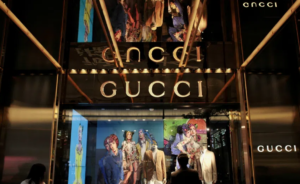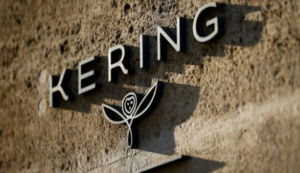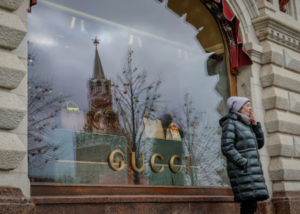Gucci’s Decline: Implications for Kering and the Luxury Industry
Kering, the renowned French luxury conglomerate, has on Wednesday unveiled projections indicating a substantial downturn in its first-half operating profit, anticipating a notable decline ranging between 40% to 45%. This sobering announcement follows a disappointing first quarter marked by a discernible reduction in sales, particularly evident in the performance of its flagship brand, Gucci.
Right after the projection, it’s shares fall by 8%.

Despite its storied legacy and widespread acclaim, Gucci experienced a downturn in patronage as affluent consumers exhibited restraint in their expenditure on luxury goods.
During the three-month period concluding in March, Kering reported a significant decrease in sales, with figures reflecting a 10% decline on a comparable basis, amounting to 4.5 billion euros (approximately $4.8 billion). The company had previously cautioned investors on March 19th about the likelihood of such a sales downturn, effectively dispelling any hopes of a reversal in the declining sales trend at Gucci.
Notably, Gucci, with its illustrious heritage and iconic status, constitutes a substantial portion of Kering’s overall sales, accounting for half of the group’s revenue and a significant two-thirds of its profit margin. This persistent downturn in Gucci’s performance underscores broader challenges faced by the luxury industry, as shifts in consumer behavior and economic uncertainties continue to impact spending patterns among affluent clientele.
Gucci’s China Woes: Impact on Kering and Luxury Market
The cautionary message issued by Kering has sparked apprehension within the luxury sector regarding the potential resurgence of China’s market, traditionally recognized as the prized domain for Gucci. However, this anticipated recovery has been overshadowed by a confluence of challenges, including a burgeoning property crisis and soaring youth unemployment rates.
Gucci, renowned for its allure and popularity among Chinese consumers, faced a notable setback in the first quarter, with sales plummeting by a staggering 18%. This downturn represents a significant exacerbation compared to the comparatively modest 4% decline witnessed in the preceding quarter, further underscoring the gravity of the situation.

As a consequence of this revenue downturn and the ongoing necessity for substantial investments in the brand, the prospects for first-half profits have been significantly dampened. Moreover, company executives, speaking to analysts during a conference call, expressed little optimism for a substantial improvement in Gucci’s performance during the second quarter.
This outlook underscores the enduring challenges confronting the brand and the broader luxury industry, as they navigate through a landscape marked by economic uncertainties and shifting consumer preferences.
Adapting to Shifting Consumer Tides: Kering’s Response in China
The magnitude of the projected decline in first-half profits has surpassed initial expectations, marking a notable divergence from anticipated outcomes. Analysts at Bernstein remarked that while it is understandable for brands undergoing transition to encounter challenges amidst a backdrop of softening demand, the extent of the profit decline has nevertheless caught many off guard.
This observation underscores the profound impact of shifting consumer preferences, as individuals prioritize spending on established and highly coveted brands, relegating those in transition to the sidelines.
 Furthermore, Kering executives highlighted that luxury store traffic in Asia has been notably subdued, further exacerbating the challenges faced by the company and its peers in the region. This decline in footfall reflects broader trends in consumer behavior, signaling a cautious approach to discretionary spending amidst economic uncertainties and evolving market dynamics.
Furthermore, Kering executives highlighted that luxury store traffic in Asia has been notably subdued, further exacerbating the challenges faced by the company and its peers in the region. This decline in footfall reflects broader trends in consumer behavior, signaling a cautious approach to discretionary spending amidst economic uncertainties and evolving market dynamics.
As luxury brands grapple with these formidable headwinds, they are compelled to adapt their strategies and offerings to align with evolving consumer preferences and market realities. Armelle Poulou, the Chief Financial Officer of Kering, elucidated on the current dynamics within the Chinese market, noting a discernible polarization in consumer preferences.
Navigating Gucci’s Positioning and Anticipation in China
On one end of the spectrum, there exists a robust appetite among clientele for products positioned at the pinnacle of luxury, while on the other, there is a growing demand for more affordable offerings. Gucci, positioned somewhat in the middle of this spectrum, finds itself in a challenging position, as it has not been able to capitalize on this polarization in consumer preferences.

Poulou emphasized that Gucci’s positioning has hindered its ability to fully benefit from this polarization, thereby contributing to its subdued performance in the market. However, she expressed optimism that this situation is not static and could evolve rapidly in the future, potentially presenting new opportunities for the brand.
In addition to the market dynamics, Poulou highlighted another factor contributing to Gucci’s struggles in China – the anticipation surrounding the arrival of its new collection in stores. She noted that Chinese shoppers are currently holding back their purchases, awaiting the unveiling of Gucci’s latest offerings. This delay in consumer spending further compounds the challenges faced by the brand in the Chinese market, as it navigates through a landscape characterized by shifting consumer preferences and heightened anticipation for new releases.










